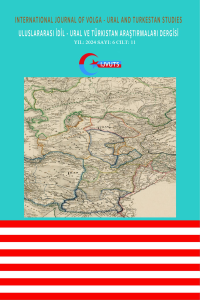Öz
The purpose of our work was to analyze the ethnic realities of the Kipchak language in order to
establish its similarities and differences with modern Turkic languages for which this medieval
language was a proto-language. The written medieval manuscript in Arabic “Al-Tuhfa al-Zakiyya fi al-
Lugha al-Turkiyyah” (Genuine wonder about the Turkish language) was one of the most important and
most valuable source for studying the Kipchak language. The main feature of the work was that the
original version was written in the Kipchak, as the anonymous author pointed out on the first page of
the manuscript, stored in Istanbul, in the Beyazit state library. When studying objects that were far
apart from each other in a temporary sense, such as medieval and modern languages, we used the
comparative-historical method, and as a result concluded that in some cases there were only phonetic
differences, while the syntactic and semantic commonality of lexical and phraseological units persisted.
To classify ethnic realities, the statistical method of analysis was used. Ethnographic, cultural and
mental realities testified to direct kinship and a single nomadic culture of the speakers of the languages
of this group and provided an opportunity to restore the historical stages of the development of the
Turkic languages from the Middle Ages to the present day.
Anahtar Kelimeler
Ayrıntılar
| Birincil Dil | İngilizce |
|---|---|
| Konular | Kuzey-Batı (Kıpçak) Türk Lehçeleri ve Edebiyatları, Çağdaş Türk Lehçeleri ve Edebiyatları (Diğer) |
| Bölüm | Çeviri / Aktarma |
| Çevirmenler | |
| Yayımlanma Tarihi | 29 Şubat 2024 |
| Gönderilme Tarihi | 2 Şubat 2024 |
| Kabul Tarihi | 26 Şubat 2024 |
| Yayımlandığı Sayı | Yıl 2024 Cilt: 6 Sayı: 11 |


